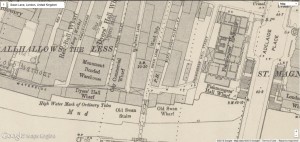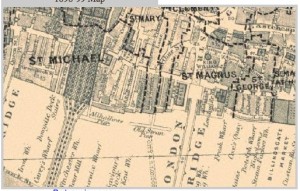In Sir Arthur Conan Doyle’s short Sherlock Holmes story, “The Man with the Twisted Lip”, the reader is introduced to the eerie and narrow Upper Swandam Lane based on its realistic counterpart, Swan Lane.
Upper Swamdam Lane, according to Dr. Watson is “a vile alley lurking behind the high wharves which line the north side of the river to the east of London Bridge. Between a slop-shop and a gin-shop, approached by a steep flight of steps leading down to a black gap like the mouth of a cave, I found the den of which I was in search” (Doyle 128). East London, as we have consistently read about, is not a nest that the rich are wont to reside. Depicted on the map above, Swan Lane looks as though it is hidden, making it a back-alley to put the poor of London with only a single entrance from Thames Street. Because of Swan Lane’s location in London, being relatively near the Thames and surrounded by various wharves and piers, the incoming trafficking of opium made Swan Lane a perfect area for Doyle to fictionalize his pivotal plot point of the opium den.
From The Charles Booth Online Poverty Archive, Swan Lane, located inside the star on the above image, is light blue in color, indicating the impoverished living in the area. Due to the poor, seemingly closed off street, and its proximity to London Bridge and Cannon Street Station, Doyle’s character Neville St. Clair is able to embody a beggar and use the opium den as a changing room from one facet of life into another. The opium den reeling in the rich to a poverty-stricken area is a perfect place to cross one social class border into another. Especially when the rich are emptying their pockets to quell their opium addictions.
All in all, the historical data from the Booth Online Poverty Archive and the location of Swan Lane bring to life Doyle’s depiction of Upper Swandam Lane, as well as accurately expose a pocketed opium den. Through this, Doyle is able expose corruption of social class and addiction through a narrow port area.
_________________
Works Cited:
Doyle, Arthur Conan. The Man with the Twisted Lip. N.p.: n.p., n.d. Print.
“Booth Poverty Map & Modern Map (Charles Booth Online Archive).” Booth Poverty Map & Modern Map (Charles Booth Online Archive). N.p., n.d. Web. 18 Oct. 2015.




